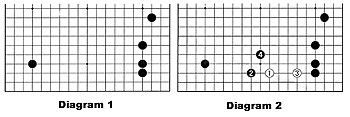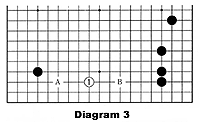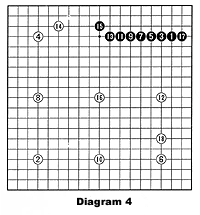Go and business (1)
In chess, the object is to checkmate the opponent's king. In the course of the game, a player might capture many of the opponent's pieces to gain a strategic advantage and make it easier to checkmate the king. This is very much like war.In go, you can profit in the short term by capturing a few stones, but this could be a strategic mistake if it does not take into account the overall territorial balance of the board. Likewise in business, companies that seek a short-term profit are not likely to be around for long. The most successful companies are those that hunker down and patiently plan their long-term strategy to compete with their rivals.
Market sharing
Go is a game in which each player competes to control as much territory as possible. Since it is impossible to prevent your opponent from gaining some territory, you must play so as to maximize your own territorial profit and minimize your opponent's. The competition for territory takes place in many parts of the board--in the corners, along the sides, and in the center. A player may come out with a disadvantage in one part of the board, but it will be compensated for by an advantage in another part. This is similar to business strategy where companies try to capture a share of the market.In 1995, Yasuyuki Miura, a former executive of Japan Airlines, published a book titled "Go: An Asian Paradigm for Business Strategy." In that book he describes how he used go strategy to set up a billion-dollar business in the United States and gave many examples of how Japanese enterprises use it in their own strategic planning. One interesting example he gave was how the strategy of controlling territory in go was similar to the way Nissan and Toyota competed for shares in the automobile market.
According to Miura, Nissan was content take a 30 percent share of the economy-car market while conceding a 40 percent share to Toyota. In this way, the competition (game) could continue with neither side being driven from the market (checkmated). Nissan could survive with a 30 percent market share, while it fought to improve this share. Moreover, the economy-car market was only one part of the "car-market board." There remained other areas of competition: the luxury-car market, sports, mini-van, etc. In the course of their competition, strategic placements of new models could increase their market shares.
Thickness
 In go, positions are often referred to as "thick." A thick position is one which has few or no defects. The position is strong and the stones making them up are almost invulnerable to capture. Furthermore, any attack against them is very likely to end in failure. In Diagram 1, the black stones on the right make up a thick position. Not only do these stones solidly control the territory on the right side, they also radiate strong influence along the bottom and even into the center.
In go, positions are often referred to as "thick." A thick position is one which has few or no defects. The position is strong and the stones making them up are almost invulnerable to capture. Furthermore, any attack against them is very likely to end in failure. In Diagram 1, the black stones on the right make up a thick position. Not only do these stones solidly control the territory on the right side, they also radiate strong influence along the bottom and even into the center.White must be careful when playing in the vicinity of a thick position. If he plays too close to Black's thickness, his stones will be come under severe attack.
For example, White 1 in Diagram 2 is too close to Black's thick position. Black will attack with 2. White can try to make a base by extending to 3, but Black jumps to 4, limiting White's access to the center and forcing him to make a living group at the bottom. White's stones might survive, but they will end up with only minimum territory, isolated, and lacking strategic influence.
 If White wants to play in this part of the board, he should play at 1, far away from the black stones on the right. He now has room to maneuver. That is, he can extend to A or B in Diagram 3. If Black attacks from the left White can extend to B and his position at the bottom will still be far enough away from the black stones so as to be virtually out of danger.
If White wants to play in this part of the board, he should play at 1, far away from the black stones on the right. He now has room to maneuver. That is, he can extend to A or B in Diagram 3. If Black attacks from the left White can extend to B and his position at the bottom will still be far enough away from the black stones so as to be virtually out of danger.
There is a maxim in go that goes like this: "Don't play near thickness!" This same maxim is also applicable in business strategy. An entrepreneur would usually not choose to open a store in an area where there were already many established stores selling the same product line. Instead, he would look for an area in which there is little competition. In general, it is considered dangerous to go into any kind of business where there are many established companies that dominate the market. A recent example can be found in the soft drink business in the United States where a British company is attempting to crack the strangle-hold that PepsiCo and Coca-Cola. have on the soft-drink market. The obstacles the new company faces are nearly insurmountable, but the soft-drink market is so huge, that even a minuscule market share would translate into a success.
Still, in business as in go, the best chance for success is to enter areas that are not dominated by the competition.
Diversification
Diversification is important for the long-term survival of all businesses. By concentrating on one field of business or product you run the risk of losing the edge. Successful trading companies hedge the exchange-rate risk by both importing and exporting. A company that has many products to sell will have a more stable business than one that has few. As the old adage advises, "Don't put all of your eggs in one basket. "
 It is the same in go. Concentrating your stones in only one part of the board is bad strategy. Diagram 4 is a good example. Black plays all of his moves in the upper right, securing almost 30 points of iron-clad territory. White, on the other hand, is playing his stones throughout the board. He has mapped out more than 200 points of territory. Even if Black now starts skillful invasions of White's sphere of influence, it will be nearly impossible for him to make up this 170-point-plus deficit.
It is the same in go. Concentrating your stones in only one part of the board is bad strategy. Diagram 4 is a good example. Black plays all of his moves in the upper right, securing almost 30 points of iron-clad territory. White, on the other hand, is playing his stones throughout the board. He has mapped out more than 200 points of territory. Even if Black now starts skillful invasions of White's sphere of influence, it will be nearly impossible for him to make up this 170-point-plus deficit.
Answer to last week's problem
 In Problem 1 you were asked to save the four marked black stones by capturing the white ones. The tesuji is for Black to throw in a stone at 1 in Diagram 5. White must capture with 2 and Black atari with 3. White gets out of atari by connecting with 4 in Diagram 6, but Black ataris again with 5 and White has no escape.
In Problem 1 you were asked to save the four marked black stones by capturing the white ones. The tesuji is for Black to throw in a stone at 1 in Diagram 5. White must capture with 2 and Black atari with 3. White gets out of atari by connecting with 4 in Diagram 6, but Black ataris again with 5 and White has no escape.
